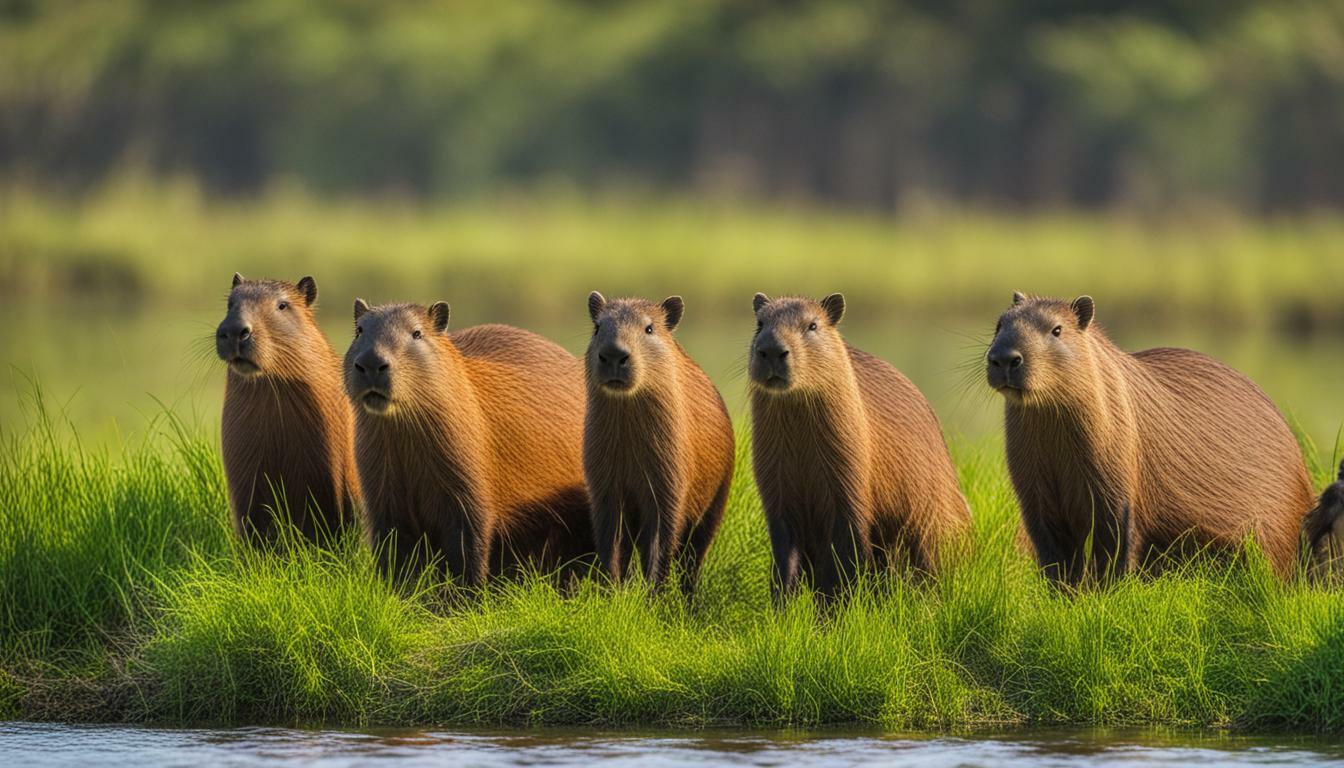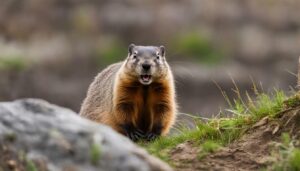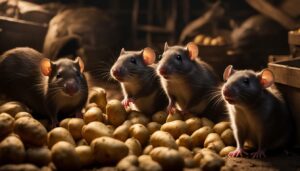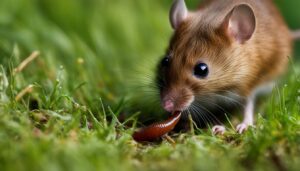Capybaras, the largest rodents in the world, have several enemies in the wild. These gentle creatures, native to South America, face threats from a variety of predators. From fierce reptiles like caimans and anacondas to powerful big cats such as pumas, jaguars, and ocelots, capybaras must constantly be on guard to survive. Even birds like harpy eagles and mammals like crab-eating foxes pose a danger to these peaceful herbivores.
However, perhaps the greatest threat to capybaras comes from humans. For centuries, capybaras have been hunted for their meat, pelts, and hide. The overhunting by humans has led to the decline and disappearance of capybaras in some areas. Yet, they are also farmed for their meat in certain regions, adding an interesting dynamic to their predator-prey relationships.
Key Takeaways:
- Capybaras face enemies in their natural habitats, including reptiles, big cats, birds, and mammals.
- Reptiles like caimans and anacondas pose a threat to capybaras.
- Big cats such as pumas, jaguars, and ocelots hunt capybaras for food.
- Birds like harpy eagles and mammals like crab-eating foxes also prey on capybaras.
- Humans have been the greatest predators of capybaras, hunting them for their meat, pelts, and hide.
Predators in the Wild
In the wild, capybaras are targeted by a variety of predators. These fascinating creatures, native to South America, have adapted to survive in diverse habitats, but they are not without their enemies. Let’s explore some of the predators that pose a threat to capybaras in their natural habitats.
One of the main predators of capybaras is the caiman, a large reptile known for its powerful jaws and stealthy hunting techniques. Capybaras must be cautious when venturing near bodies of water, as caimans lurk beneath the surface, waiting for an opportunity to strike. Another formidable predator is the anaconda, a massive snake that can overpower even the largest capybaras with its constricting coils.
When it comes to big cats, capybaras face the dangers posed by pumas, jaguars, and ocelots. These sleek and agile predators have the ability to ambush capybaras, using their speed and stealth to their advantage. In the realm of birds, harpy eagles pose a threat to capybaras, especially their young. These majestic birds of prey have sharp talons and a powerful beak, making them formidable hunters.
In addition to reptiles, big cats, and birds, capybaras also have to contend with mammalian predators. Crab-eating foxes, for example, are skilled hunters that can easily catch smaller capybaras. Their hunting strategies and agility make them a significant threat to capybara populations. However, despite these numerous natural enemies, the biggest threat to capybaras remains human predation.
| Predators | Threat Level |
|---|---|
| Caimans | High |
| Anacondas | High |
| Pumas | Moderate |
| Jaguars | Moderate |
| Ocelots | Moderate |
| Harpy Eagles | High |
| Crab-eating Foxes | Moderate |
| Humans | Extreme |
Humans have been hunting capybaras for centuries for their meat, pelts, and hide. This overhunting has had a devastating impact on capybara populations in some areas, leading to their disappearance. However, it is worth noting that capybaras are also farmed for their meat in certain regions, which provides an alternative source and helps alleviate pressure on wild populations.
Capybaras have developed a complex predator-prey relationship with their enemies in the wild. They rely on their size, speed, and social behavior to detect and evade predators. Despite the constant threat of predation, capybaras play a vital role in their ecosystems, contributing to the balance of nature.
Threats from Reptiles and Birds
Capybaras must be wary of reptilian predators such as caimans and anacondas, as well as birds like harpy eagles. In their natural habitats of South America, these formidable predators pose a significant threat to capybara populations.
Caimans, which are large, carnivorous reptiles, are known to ambush capybaras while they are grazing near bodies of water. With their stealth and powerful jaws, caimans can quickly overpower and consume capybaras, particularly the young and vulnerable.
Anacondas, on the other hand, rely on their immense size and constricting ability to subdue capybaras. These giant snakes can squeeze their prey to death, making them a formidable threat to capybaras in their habitat. They are often found lurking near water bodies where capybaras congregate, waiting for the perfect opportunity to strike.
Harpy eagles, with their impressive wingspan and sharp talons, are skilled predators that pose a danger to capybaras. These birds of prey have been observed swooping down from the sky to snatch unsuspecting capybaras, making them a constant threat in the skies above.
As capybaras navigate their habitats, they must remain vigilant to evade these reptilian and avian enemies. The intricate dance between capybaras and their predators contributes to the delicate balance of the ecosystem, where survival and predation play a crucial role.
| Predators | Threat Level |
|---|---|
| Caimans | High |
| Anacondas | High |
| Harpy Eagles | Medium |
Dangers from Big Cats
Capybaras need to avoid encounters with big cats such as pumas, jaguars, and ocelots to ensure their survival. These powerful predators pose a significant threat to capybaras in their natural habitats. Big cats have the strength and agility to take down adult capybaras, as well as young ones.
Did You Know? Jaguars are known to have the strongest bite of any big cat, enabling them to crush the skulls of their prey with ease.
These stealthy felines rely on their keen senses and impressive hunting skills to stalk and ambush their unsuspecting prey. Pumas, known for their exceptional jumping ability, can silently approach capybaras before launching a surprise attack. Ocelots, with their remarkable agility and camouflage, can easily blend into the surroundings, making them highly effective hunters of capybaras.
Surviving in the Wild
To survive in the presence of these big cats, capybaras have developed several strategies. They utilize their large size and excellent swimming abilities to escape from predators by diving into bodies of water. Capybaras can stay submerged for a significant amount of time, evading the big cats waiting at the water’s edge.
“The ability of capybaras to navigate water swiftly and effortlessly is their ultimate defense against predation.” – Dr. Jane Anderson, Wildlife Researcher
In addition to aquatic evasion, capybaras rely on their social structure for protection. They often live in large groups, called herds, allowing them to coordinate and detect potential threats more effectively. The collective vigilance of the group provides capybaras with a higher chance of detecting approaching big cats and fleeing before an attack can occur.
| Big Cats | Characteristics |
|---|---|
| Pumas | Excellent jumpers |
| Jaguars | Strongest bite of any big cat |
| Ocelots | Agile and excellent camouflage |
Threats from Mammals
Capybaras must be cautious around mammalian predators like crab-eating foxes. These agile hunters are known for their ability to sneak up on unsuspecting capybaras and strike with swift precision. With their sharp teeth and strong jaws, crab-eating foxes can take down capybaras of all sizes, from young juveniles to full-grown adults.
While capybaras primarily feed on vegetation, they are not immune to the threats posed by carnivorous mammals. The diet of a crab-eating fox, for example, consists of small mammals, birds, and reptiles, making capybaras a viable source of food. The stealth and agility of these predators allow them to close in on their prey undetected, making it crucial for capybaras to remain vigilant and stay close to water for quick escape if necessary.
| Predator | Threat Level |
|---|---|
| Crab-eating fox | High |
In addition to crab-eating foxes, capybaras also face threats from other mammals, such as jaguars, pumas, and ocelots. These big cats are formidable predators that can overpower a capybara with their strength and agility. However, capybaras have evolved certain defense mechanisms, including staying in large groups and utilizing their excellent swimming abilities to escape from potential threats.
Despite the dangers they face, capybaras play a vital role in the ecosystem as both prey and grazers. Their presence supports the delicate balance of the food chain, and their survival contributes to the overall health and biodiversity of their habitats.
Summary:
- Capybaras must be cautious around mammalian predators, such as crab-eating foxes.
- Crab-eating foxes are agile hunters that can prey upon capybaras of all sizes.
- Jaguars, pumas, and ocelots are other mammals that pose a threat to capybaras.
- Capybaras play a crucial role in the ecosystem as both prey and grazers.
| Threat Level | Major Predators |
|---|---|
| High | Crab-eating foxes |
| Medium | Jaguars, pumas, ocelots |
Human Predation
Unfortunately, humans have been one of the greatest predators of capybaras for centuries. These gentle creatures, revered for their meat, pelts, and hide, have faced significant threats from human hunters. The captivating and elusive nature of capybaras has made them a sought-after target for their valuable resources.
Throughout history, capybaras have been hunted relentlessly, leading to population declines in certain areas. The overhunting of capybaras has been driven by the demand for their meat, which is considered a delicacy in some regions. Additionally, their pelts and hides are prized for their quality, making them valuable commodities in the fur trade.
In recent times, however, a shift towards conservation and sustainable hunting practices has been observed. Many regions have implemented regulations and restrictions on capybara hunting to protect their populations and ensure their long-term survival. These efforts aim to strike a balance between human interests and the preservation of this unique species.
Sustainable Capybara Farming
In addition to hunting, capybaras are also farmed for their meat in certain regions. This practice provides an alternative to hunting in the wild and helps reduce pressure on wild populations. Capybaras are known for their high meat yield and nutritional value, making them popular in the farming industry.
Capybara farming allows for controlled breeding and harvesting, which helps maintain population stability and contributes to the conservation of the species. The farming industry also provides economic opportunities for local communities and reduces the reliance on wild populations for capybara products.
| Predator | Main Threat |
|---|---|
| Caimans | Predation on capybaras, especially young individuals |
| Anacondas | Threat to capybaras near water bodies |
| Pumas | Ability to hunt capybaras in various habitats |
| Jaguars | Top predator of capybaras in the wild |
| Ocelots | Effective hunters of capybaras |
| Harpy Eagles | Threat to capybara young and weaker individuals |
| Crab-eating Foxes | Hunting of capybaras for food |
While capybaras face numerous threats and predators in their natural habitats, the conservation efforts and sustainable farming practices aim to protect and preserve this incredible species. By acknowledging the importance of capybaras in their ecosystems and recognizing the value of their existence, humans can work towards coexistence and ensure a future where both capybaras and humans thrive.
Impact of Overhunting
Overhunting by humans has led to the decline and disappearance of capybaras in some areas. These gentle creatures have been hunted for centuries for their meat, pelts, and hide, resulting in a significant impact on their populations. The demand for capybara products, coupled with the lack of regulations and conservation efforts, has placed a significant strain on these animals’ survival.
“The capybara is a keystone species in its ecosystem, playing a vital role in maintaining ecological balance.” – Dr. Maria Rodriguez, Wildlife Biologist
The disappearance of capybaras from their natural habitats has disrupted the delicate predator-prey relationships that exist within the ecosystem. These animals, being the largest rodents in the world, play a crucial role in shaping the vegetation and aquatic environments they inhabit. The loss of capybaras has led to imbalances in the ecosystem, impacting the populations of other species, including their predators.
Capybara Ecosystems and Predators
| Predator | Predator Type | Prey Relationship |
|---|---|---|
| Caimans | Reptile | Capable of preying on both adult capybaras and their young. Their presence shapes capybaras’ behavior, forcing them to remain vigilant near water bodies. |
| Pumas, Jaguars, Ocelots | Big Cats | Known to ambush capybaras, using their stealth and agility to catch them by surprise. Capybaras form groups to increase their chances of survival against these formidable predators. |
| Harpy Eagles | Bird | These large raptors can swoop down from the sky, targeting capybaras and their young. Capybaras use their acute senses to detect these aerial predators and take evasive action. |
| Crab-eating Foxes | Mammal | These cunning hunters primarily prey on young capybaras, taking advantage of their vulnerability. Adult capybaras, with their size and strength, are less susceptible but remain at risk. |
The impact of overhunting extends beyond the loss of capybara populations. It disrupts the intricate web of life and threatens the overall health and stability of the ecosystem. Conservation efforts are crucial to protect capybaras and maintain the delicate balance they contribute to their habitats. By raising awareness, implementing stricter regulations, and promoting sustainable practices, we can help safeguard these fascinating animals for generations to come.
Capybaras as Prey and Farming
Capybaras serve as a valuable source of meat, which has led to their farming in certain regions. These friendly and sociable creatures have been hunted by humans for centuries for their delicious meat, soft pelts, and versatile hide. However, due to overhunting, capybaras have faced a decline in some areas. To combat this, some regions have turned to capybara farming as a more sustainable and controlled way of meeting the demand for their meat.
With their high reproductive rate and ability to adapt to various environments, capybaras are well-suited for farming. By raising capybaras in captivity, farmers can ensure a steady supply of meat without posing a threat to wild capybara populations. Farming not only helps to meet the demand for capybara meat but also contributes to the local economy and provides livelihoods for communities.
Although capybara farming has its benefits, it is important to ensure that it is carried out ethically and in line with animal welfare standards. Responsible farming practices prioritize the well-being of the capybaras, providing them with proper care, ample space, and a natural diet. By promoting sustainable farming methods, we can enjoy the taste of capybara meat while also preserving the species and protecting their natural habitats.
| Capybaras as Prey and Farming: Key Points |
|---|
| Capybaras are hunted by humans for their meat, pelts, and hide. |
| Overhunting has led to the decline of capybaras in some areas. |
| Farming capybaras ensures a sustainable supply of meat while protecting wild populations. |
| Responsible farming practices prioritize the well-being of the capybaras and their natural habitats. |
The Rich Predator-Prey Relationships
The predator-prey relationships between capybaras and their enemies play a vital role in ecosystem dynamics. Capybaras have several natural enemies in their South American habitats, including caimans, anacondas, pumas, jaguars, ocelots, harpy eagles, and crab-eating foxes. These predators have evolved to hunt and feed on capybaras, ensuring a balance in the ecosystem.
One fascinating aspect of these predator-prey relationships is the adaptability of capybaras. They have developed various strategies to protect themselves from their enemies. For instance, they form large social groups, known as herds, which provide safety in numbers. Capybaras rely on their keen sense of hearing and smell to detect approaching predators, and when threatened, they can quickly take refuge in water, as they are excellent swimmers.
Furthermore, the predators themselves have adapted in response to capybaras’ defensive mechanisms. For example, caimans and jaguars have become efficient swimmers and skilled hunters in the water, allowing them to pursue capybaras in their aquatic habitats. Meanwhile, harpy eagles have developed extraordinary aerial hunting skills, enabling them to snatch capybaras from the ground or water with lethal precision.
The Importance of Predator-Prey Relationships
These intricate predator-prey relationships have a profound impact on the balance of South American ecosystems. Capybaras, as herbivores, influence the vegetation in their habitats through grazing, while their predators help regulate the capybara population. This interdependence ensures the overall health and diversity of the ecosystem.
To illustrate the significance of these relationships, let’s take a closer look at the effect of capybara predation by harpy eagles. Harpy eagles primarily hunt capybaras, exerting selective pressure on their population size and behavior. This, in turn, affects the vegetation, as large capybara populations can lead to overgrazing and alter the composition of plant species. By controlling the capybara population, harpy eagles indirectly contribute to maintaining a balanced ecosystem.
| Predator | Prey |
|---|---|
| Caimans | Capybaras |
| Anacondas | Capybaras |
| Pumas | Capybaras |
| Jaguars | Capybaras |
In conclusion, the predator-prey relationships between capybaras and their natural enemies are essential for maintaining the delicate balance of ecosystems in South America. These relationships demonstrate the complex interplay between species, with each playing a vital role in ensuring the survival and health of the ecosystem as a whole.
Conclusion
Capybaras face a wide range of enemies in their natural habitats, including reptiles, birds, mammals, and humans. In the wild, capybaras must navigate the threats posed by predators such as caimans, anacondas, pumas, jaguars, ocelots, harpy eagles, and crab-eating foxes. These predators hunt capybaras for food, targeting both adult capybaras and their vulnerable young. However, it is the human predation that poses the greatest danger to capybaras.
For centuries, humans have hunted capybaras for their meat, pelts, and hide. This overhunting has had a significant impact on capybara populations, leading to their disappearance in some areas. Despite the threats they face, capybaras are also farmed for their meat in certain regions, highlighting the complex relationship between capybaras and humans.
The rich predator-prey relationships in capybara ecosystems are crucial for maintaining the balance of nature. While capybaras have evolved to adapt to the presence of predators, the pressures they face from both natural enemies and humans highlight the importance of conservation efforts to protect these unique and fascinating creatures.
FAQ
What are the enemies of capybaras?
Capybaras have several enemies in their natural habitat in South America. Some of their main predators include caimans, anacondas, pumas, jaguars, ocelots, harpy eagles, and crab-eating foxes. Humans are also a significant threat to capybaras.
Do capybaras face threats from reptiles and birds?
Yes, capybaras are vulnerable to predators like caimans, anacondas, and harpy eagles in their natural habitats.
How do big cats pose a danger to capybaras?
Pumas, jaguars, and ocelots are among the big cats that hunt capybaras for food.
Are there any mammalian predators that threaten capybaras?
Yes, crab-eating foxes are one of the mammalian predators that pose a threat to capybaras.
How have humans impacted capybaras as predators?
Humans have hunted capybaras for centuries for their meat, pelts, and hide, making them one of the biggest predators of capybaras.
What has been the impact of overhunting on capybara populations?
Overhunting by humans has led to the disappearance of capybaras in some areas, causing significant disruptions to their ecosystems.
Can capybaras be farmed for their meat?
Yes, capybaras are farmed for their meat in certain regions.
What are some interesting predator-prey relationships involving capybaras?
Capybaras have intricate relationships with their predators, with each playing a critical role in maintaining the balance of their ecosystems.




